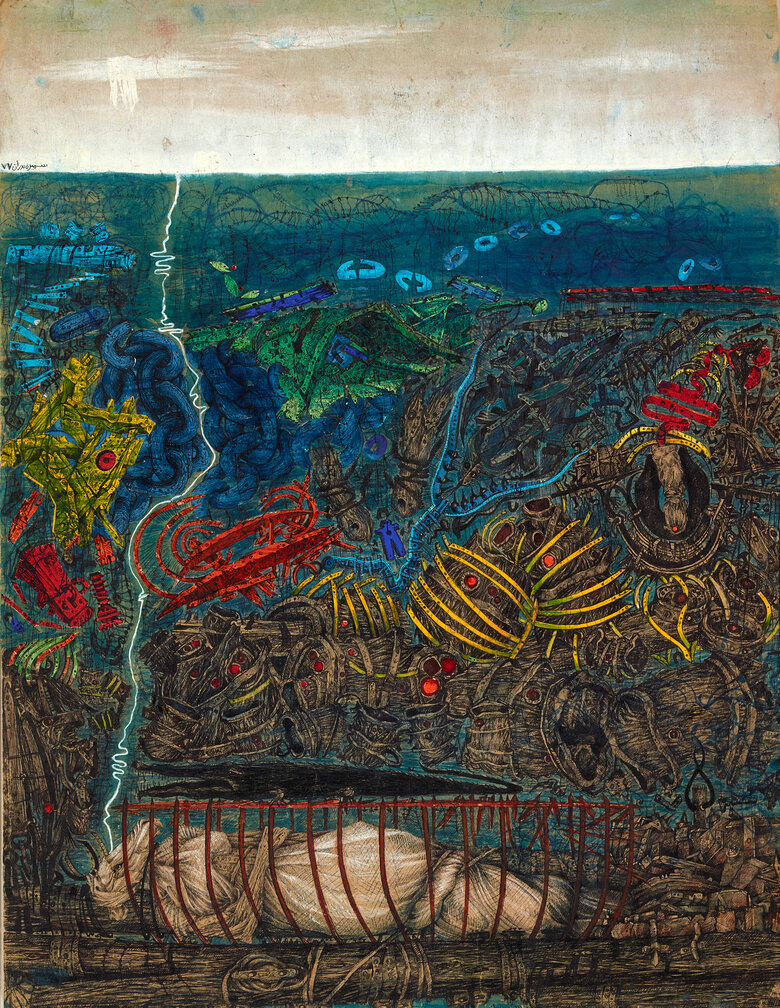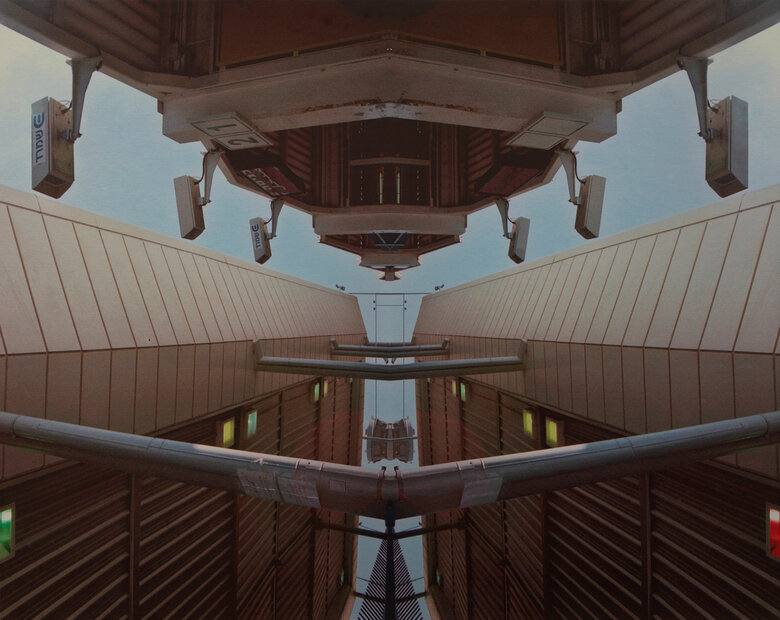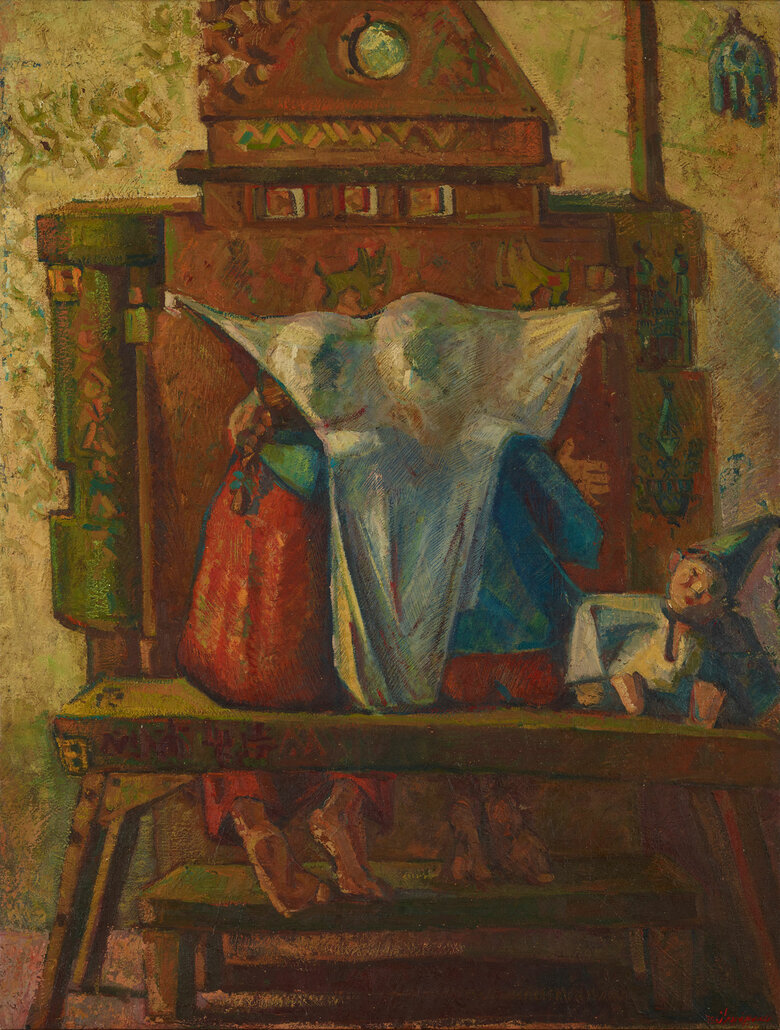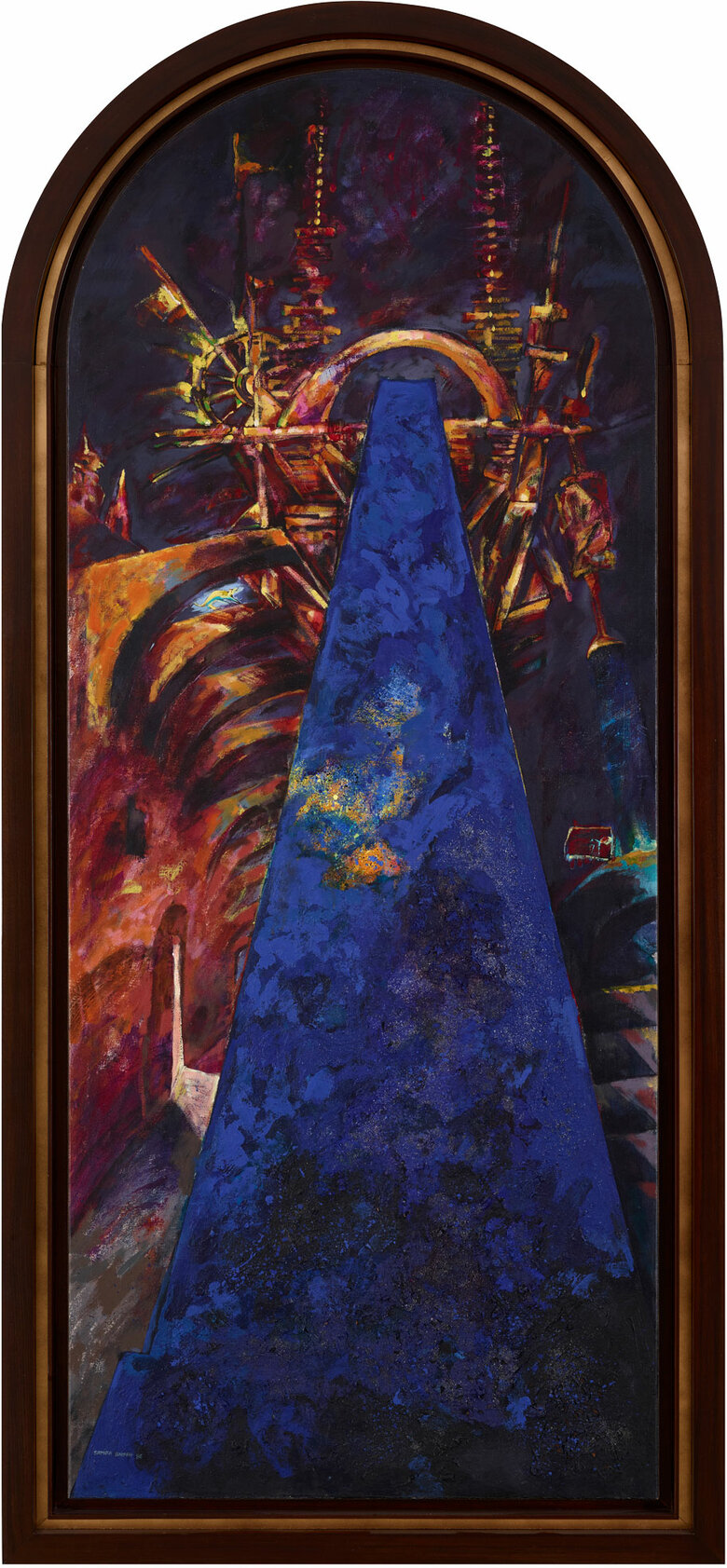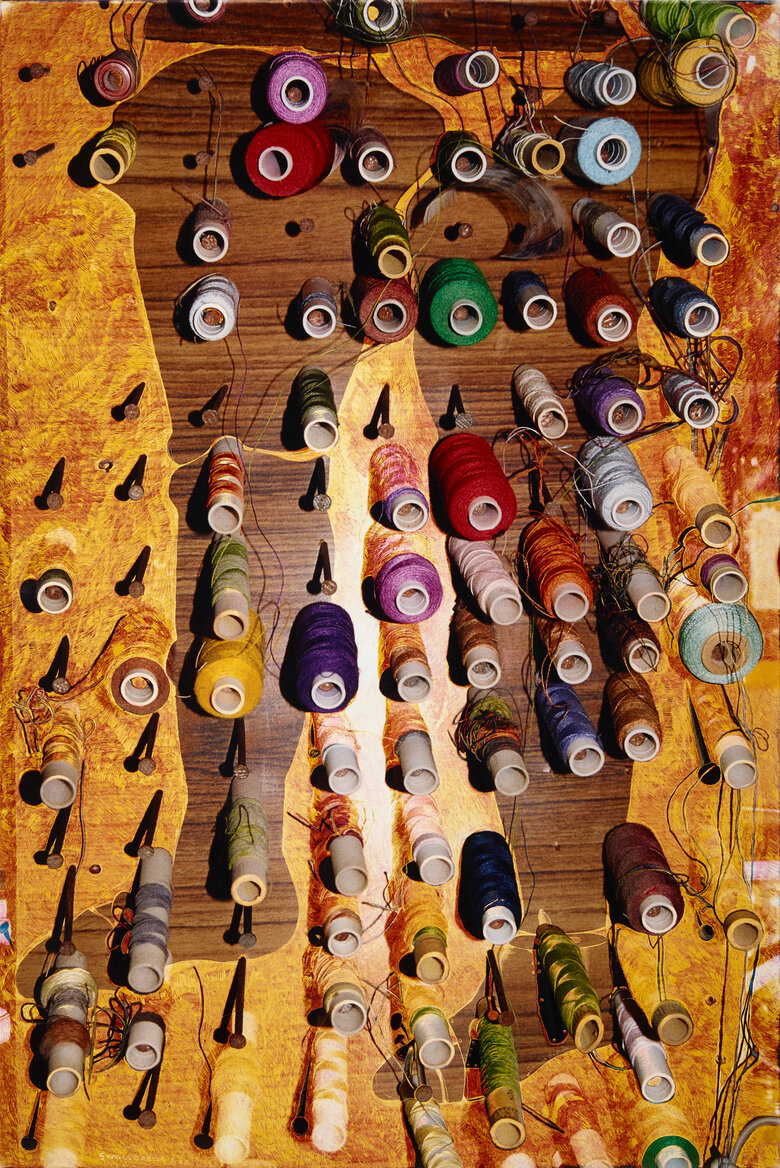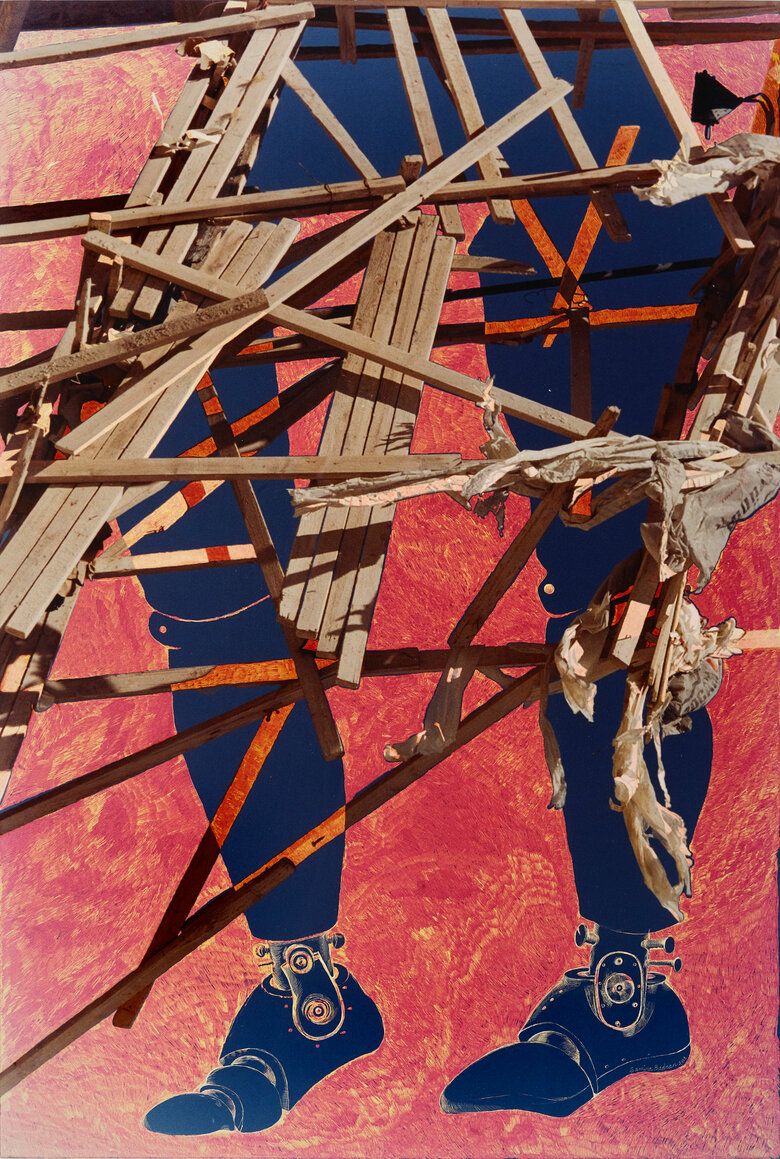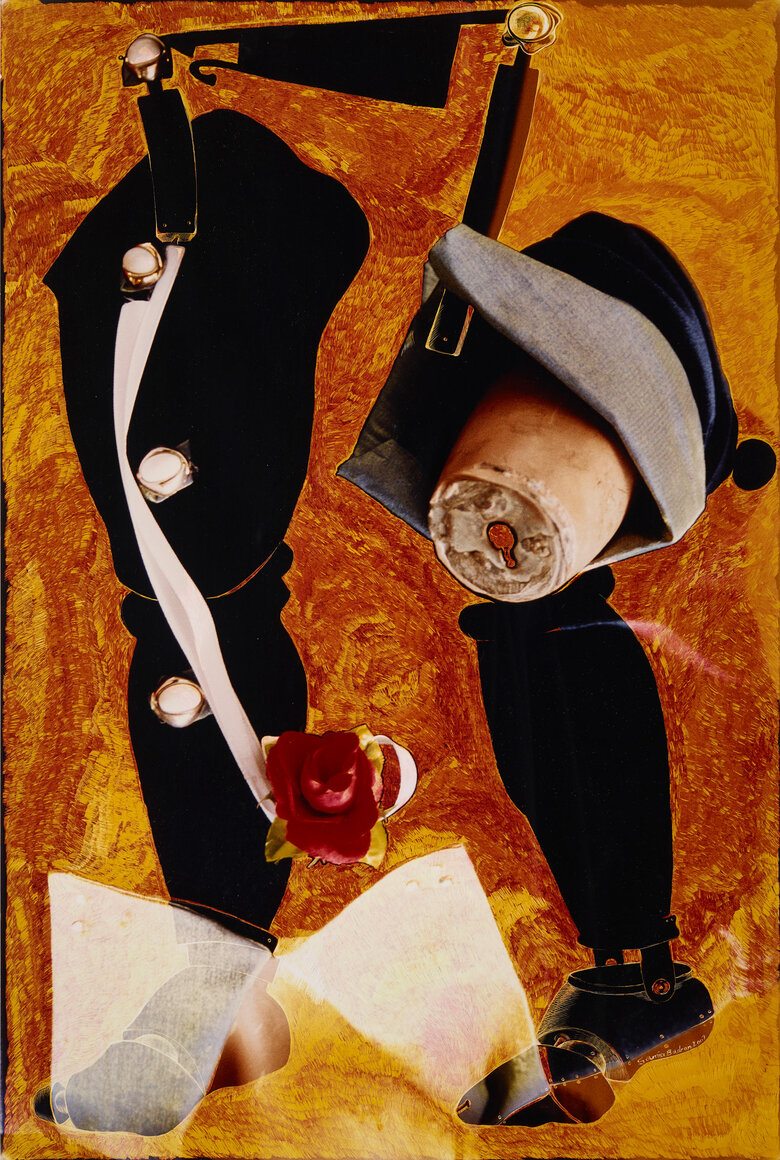Samira Badran was born in Tripoli, Libya, in 1954, into a family of noteworthy Palestinian artists. Her father, Jamal Badran (1909-1999), was an artist and an expert in the field of Islamic arts...
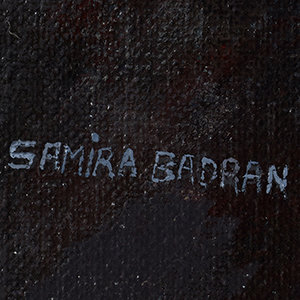

SAMIRA BADRAN, Palestine (1954)
Bio
Written by Alessandra Amin
Samira Badran was born in Tripoli, Libya, in 1954, into a family of noteworthy Palestinian artists. Her father, Jamal Badran (1909-1999), was an artist and an expert in the field of Islamic arts and crafts. A skilled sculptor and painter, he applied his expertise to materials as varied as parchment, paper, ceramic, wood, and glass, and was also prolific in artistic bookbinding and embossed leather works. Along with his brothers, Abdel Razzaq, a photographer, and Khairy, a weaver, Jamal Badran established a studio in Jerusalem in 1945 for the advancement of national and Islamic artistic traditions. Though the Badrans lost the studio during the Nakba, forcing Jamal to relocate his work to Libya, the family moved back to Palestine in 1962, where Jamal founded his arts and crafts studio in Ramallah. [i] He also played an essential role in the restoration and renovation of the burnt minbar (pulpit) of Al-Aqsa Mosque.[ii]
At the outset of the Six-Day War in 1967, the Badrans left Palestine for Amman and then Beirut, where they spent six months before returning to their home in Ramallah. This experience left a deep impression on thirteen-year-old Samira, who recalls the terror of hearing Israeli fighter planes above her family’s house, and the humiliation of being strip-searched at the border when she re-entered the country.[iii]
Samira graduated from the Academy of Fine Arts in Cairo in 1976 and completed graduate training in etching and painting at the Academia de Belle Arti in Florence in 1982. During the two years that elapsed between finishing in Egypt and beginning in Italy, Badran taught art at the UNWRA-run women’s teacher training center in Ramallah. During this short period, she made a number of mixed-media drawings that the artist herself considers “nightmarish.”[iv] Using ink, watercolor, and collage on brown paper, Badran evokes the suffocating difficulty of life under occupation through imaginative, vivid compositions in which machines and everyday materials seem to take on lives of their own. In Twenty-Five Barrels (1977), for example, a hominid figure lies wrapped in a shroud and bound to a wooden pole by ropes, completely enclosed in a cage except for its horse-like head. Atop the cage, an alligator lies beneath heaping piles of barrels, broken and distorted, many of which seem to have eyes and even faces. Throughout the dense, intricate drawing, Badran thwarts her audience’s efforts to distinguish between the organic and the mechanical, creating a tangle of hybrid forms that appear simultaneously as creatures, objects, and machines. As the viewer’s eye progresses from the earthier, warmer lower register to the cooler, brighter upper register, it finds itself repeatedly ensnared by the immense detail of the drawing, lingering on figures at once familiar and foreboding. The sense of crowding created by the image is palpable; one thinks of the densely populated refugee camps where Badran taught during this era, the inhabitants of which were living in a land that felt both like home and like an alien landscape.
This piece, which appeared in one of Badran’s earliest exhibitions, is characteristic of her work in the late 1970s. Drawings such as Horse (1976), Jerusalem (1977), and Cement Machine (1977) show similar formal preoccupations with bundles and folds of fabric, tightly-wound coils of wire and rope, and pieces of broken machinery, and are populated by the artist’s hybrid, Frankenstein-esque creatures. There is a certain futility to them: they feature dwellings that cannot provide shelter, beings that cannot move, machines that do not seem to work.
Although her artistic practices have evolved over her forty-year career, Samira Badran continues to produce work that considers themes of mobility and claustrophobia in the Palestinian context. One example can be found in her first short film, Memory of the Land (2017), a mixed-media animation, where the protagonist of this film is a pair of legs without an upper body, which Badran has stated she designed in order emphasize the severe Israeli restriction of Palestinian movement between areas of their fragmented territory.[v]
Samira Badran has exhibited extensively across the globe in cities as diverse as Florence, Baghdad, London, Jerusalem, and Washington, DC. She has lived and worked in Barcelona since the early 1980s.
[i] For more on Jamal Badran, see Kamal Boullata, Palestinian Art from 1850 to the Present. London; Berkeley, California: Saqi (2009): pp. 70-77.
[ii] Personal correspondence with artist, May 2020
[iii] “Encounter with Samira Badran” (video) by sobhi on Vimeo: https://vimeo.com/94626533
[iv] Ibid.
[v] See Errika Zacharopoulou’s interview with Samira Badran for the 2018 Glasgow Film Festival: https://glasgowfilm.org/glasgow-short-film-festival/shows/memory-of-the-land-an-interview-with-samira-badran
Sources
Artist’s website: http://www.samirabadran.com
Amirsadeghi, Hussein, Salwa Mikdadi, and Nada Shabbout, eds. New Vision: Arab Contemporary Art in the 21st Century. London: TransGlobe Publishing, 2009: pp. 90-93
Bland, Salua, ed. Filastin al-Hadara (exhibition catalog). Amman: The Khalid Shoman Foundation – Darat al-Funun, 2018: pp. 198-207
Boullata, Kamal. Between Exits: Paintings by Hani Zurob. London: Black Dog Publishing, 2012: pp. 120-124
Boullata, Kamal. Palestinian Art from 1850 to the Present.London: Saqi, 2009: pp. 26; 272-274
Halaby, Raouf. “Art Palestine International’s 2014 Exhibit.” Counterpunch website, 28 March 2014. https://www.counterpunch.org/2014/03/28/art-palestine-internationals-2014-exhibit/
Interview with Erika Zacharopoulou for Glasgow Film Festival, 2018: https://glasgowfilm.org/glasgow-short-film-festival/shows/memory-of-the-land-an-interview-with-samira-badran
Obrist, Hans Ulrich and Hoor al-Qasimi, Do It Bil Arabi (exhibition catalog). Sharjah: Sharjah Art Foundation, 2016: pp. 98-99, 104-105
Slitine, Marion. “Bridge to Palestine: Voyage au Coeur de la Création Contemporaine Palestinienne.” ONORIENT Agency website, 29 September 2015. http://onorient.com/bridge-to-palestine-voyage-coeur-de-creation-contemporaine-palestinienne-9061-20150929
Subcontracted Nations (exhibition catalog). Ramallah: A.M. Qattan Foundation, 2018: p. 263
CV
Selected Solo Exhibitions
2017
Samira Badran: Memory of the Land, (section of the exhibition Falastin al-Hadara), Blue House, Darat Al Funun, Amman, Jordan
2012
Have a pleasant stay, Nova Espai Àgora Catalunya, Barcelona, Spain
2008
Rovira I Virgili University, Salou, Spain
1996
La Tramontana, Chaillé les Marais, France
1987
The British Council, Amman, Jordan
1985
Galeria Piscolabis, Barcelona, Spain
Royal Cultural Center, Amman, Jordan
Selected Group Exhibitions
2024
From Palestine With Art, P21 Gallery, Fitzrovia, London, UK
2023
In Solidarity with Palestine, Darat al Funun, Amman, Jordan
The Little Prince of Gaza, Dalloul Art Foundation (DAF), Beirut, Lebanon
On This Land, Alserkal Avenue, Dubai, United Arab Emirates
2020
Along the Path, 150 Years of Palestinian Art, Bank of Palestine/Bethlehem, Occupied Palestine
2019
Intimate Terrains: Representations of a Disappearing Landscape, The Palestinian Museum, Birzeit, Occupied Palestine
2018
Oh Bader, it’s as if we never came and never left, Fattoush Gallery, Haifa, Occupied Palestine
31es Instants Vidéo, La Friche Belle de Mai, Marseille, France
Subcontracted Nations, al-Qattan Foundation, Ramallah, Occupied Palestine
Keyword- Palestine, Dar El-Nimer for Arts and Culture, Beirut, Lebanon
Glasgow Short Film Festival, Scotland, UK
2017
Bideodromo 2017, Bideodromo- Experimental film and Video Festival, Bilbao, Spain
Falastin Al- Hadara, Darat al Funun, Blue House, Amman, Jordan
2016
Do It in Arabic, Sharjah, UAE & Darat al-Funun, Amman, Jordan
2015
Samira Badran and Hassan Musa, Pôle scientifique et culturel, Rochbelle-Alès, France
2014
Manam, in Qalandia International 2, Arab Culture Association, Haifa, Occupied Palestine
Bridge to Palestine, Mark Hachem Gallery, Beirut, Lebanon
How Green Was My Valley, Whitebox Art Center, New York City, USA
Gallery One, Ramallah, Occupied Palestine
2011
Between Ebal and Gerzin, Cities Exhibition, 3rdEdition, public spaces in Nablus and at Birzeit University Museum, Occupied Palestine
Framed/Unframed, Birzeit University Museum, Occupied Palestine
2009
Al-Quds: A Celebration of Jerusalem, Nabad Gallery, Amman, Jordan
Beyond the Border: Palestinian Artists, Rafia Gallery, Damascus, Syria
Jerusalem Syndrome, Al Ma’mal Foundation, Jerusalem, Palestine
Poble Nou Amb Palestina, Can Felipa, Barcelona, Spain
Sharjah Biennial 9, UAE
Mirades Sobre Palestina, Gallery Pa Tothom, Barcelona, Spain
2008
No Man’s Land? Contemporary Art from Palestine, Gemeentemuseum, Den Haag/Gernak, the Netherlands
2007
Badrans: A Century of Tradition and Innovation, Palestinian Art Court – Al Hoash, Jerusalem, Occupied Palestine; Birzeit University Museum, Birzeit, Occupied Palestine
2006
Filles de la Diaspora, Centre de Cultura La Merce, Girona, Spain
2005
Narrative of an Arab Family, Foreign Ministry, Berlin, Germany
2002
Breaking the Veil: Women Artists from the Islamic World, toured Greece, Spain, Italy, Luxembourg, and France
From the Ocean to the Gulf and Beyond: Arab Contemporary Art Exhibition, Jordan National Gallery of Fine Art, Amman
2000
Journey through the Contemporary Arts of the Arab World, Darat al Funun, Amman, Jordan
1995
Al-Fann: Contemporary Art from Islamic and Islam-Influenced Countries, Kulturhaus, Dock4, Kassel, Germany
1994
Occupied Palestine: Forces of Change, Al-Wasiti Art Center, Jerusalem, Occupied Palestine
Women Artists from the Arab World, National Museum of Women in the Arts, Washington, DC; toured the US
1990
Arte-Intifada, Centro Internazionale Multimedia, Salerno, Italy
1989
Tercera Bienal, Havana, Cuba
1988
It’s Possible, The Great Hall Gallery, New York, USA
L’Art Contemporain en Jordanie, Musée du Luxembourg, Paris, France
Eight Jordanian Artists, Darat Al Funun, Amman, Jordan
1986
V Saló de Tardor, Saló del Tinell, Barcelona, Spain
1983
Uno Spazio per l’Arte, Comune di Busto Arsizio, Milan, Italy
Quindici Giovani Pittori, Bagno a Ripolli, Florence, Italy
1981
Mostra delle Giovane Presenze Artistiche in Toscana, Galleria Comunale d’Arte Moderna, Forte dei Marmi, Italy
1980
The First National Art Exhibition for Arab Women Artists, Modern Art Gallery, Baghdad, Iraq
Arab Women Artists, Chelsea Library, London, UK
1978
International Art Exhibition for Palestine, Beirut, Lebanon
1977
Palestinian Art Exhibition, Bethlehem University, Occupied Palestine
Palestinian Artists of the Occupied Land, touring exhibition across 8 U.S. States
1976
Palestinian Artists’ Exhibition, Y.W.C.A., Jerusalem, Occupied Palestine
Collections
Birzeit University Museum, Occupied Palestine
Ramzi & Saeda Dalloul Art Foundation, Beirut Lebanon
Jordan National Gallery, Amman, Jordan
George Al-Ama private Collection, Bethlehem, Occupied Palestine
The Khalid Shuman Foundation, Darat Al-Funun, Amman, Jordan
Private Collection of "Scuola di Musica di Fiesole, Fondazione O.N.L.U.S"- Fiesole, Italy
Barjeel Art Foundation, Sharjah, UAE
Press
Palestine Filmer c'est exister
Palestine Filmer C’est Exister, French
Artists Talk: How Green Was My Valley Moved to Whitebox Art Center | Alwan For The Arts
Center for Palestine Studies, Alwan for the Arts, ArtPalestine International and Whitebox, English, 2014
ARTIST OF THE DAY: PALESTINIAN SAMIRA BADRAN
isqineeha, English, 2013
Houston Palestine Film Festival celebrates 13 years of Palestinian films
Nicole Sawaya
Mondoweiss, English, 2019
Exposició “Have a Pleasant Stay” (Naqba 2012)
Amb El Liban
Memory of the Land’ at The Khalid Shoman Foundation (10 october 2017-11 january 2018)
Darat Al Funun, English, 2017
Journey through the Contemporary Arts of the Arab World BILAD AL SHAM (2): PALESTINE, LEBANON AND SYRIA
Darat Al Funun, English, 2000
Lever le Voile: Femmes Artistes en Terre d'Islam
Universes in Universe , French, 2004
Art Palestine International’s 2014 Exhibit
RAOUF J. HALABY
Counterpunch, English, 2014
How green is my valley?
RAOUF J. HALABY
Le Monde Diplomatique, English, 2014
"Bridge To Palestine : Voyage Au Cœur De La Création Contemporaine Palestinienne "
MARION SLITINE
onorient.com, French, 2015
Aesthetics of distress and hope: Two complementary exhibitions showcase Palestineʼs rich cultural heritage
Sally Bland
The Jordan Times, English, 2017
سميرة بدران تصطدم بمرارة الواقع في ذاكرة الأرض
Al Watan, Arabic, 2018
Deep roots of Palestinian culture
Sally Bland
The Jordan Times, English, 2018
Along the Path, 150 Years of Palestinian Art
George Al Ama and Nada Atrash
This week in Palestine, English, 2020
Alès _ Hassan Mussa et Samira Badran au pôle de Rochebelle - midilibre.fr.pdf
Kitab_ Five Arab Art and Culture Books To Add To Your Library _ Vogue Arabia.pdf
SAMIRA BADRAN Artwork
Become a Member
Join us in our endless discovery of modern and contemporary Arab art
Become a Member
Get updates from DAF
Follow Artists
Save your favourite Artworks
Share your perspectives on Artworks
Be part of our community
It's Free!
We value your privacy
TermsCookiesPrivacy Policies
Become a Member
Get updates from DAF
Follow Artists
Save your favourite Artworks
Share your perspectives on Artworks
Be part of our community
It's Free!
We value your privacy
TermsCookiesPrivacy Policies
Become a Member
Get updates from DAF
Follow Artists
Save your favourite Artworks
Share your perspectives on Artworks
Be part of our community
It's Free!
We value your privacy
TermsCookiesPrivacy Policies
Welcome to the Dalloul Art Foundation
Thank you for joining our community
If you have entered your email to become a member of the Dalloul Art Foundation, please click the button below to confirm your email and agree to our Terms, Cookie & Privacy policies.
We value your privacy, see how
Become a Member
Get updates from DAF
Follow Artists
Save your favourite Artworks
Share your perspectives on Artworks
Be part of our community
It's Free!
We value your privacy
TermsCookiesPrivacy Policies

-New-Walk-image-from-the-artistJPG.jpg)
-New-Walk-image-from-the-artistJPG.jpg)
